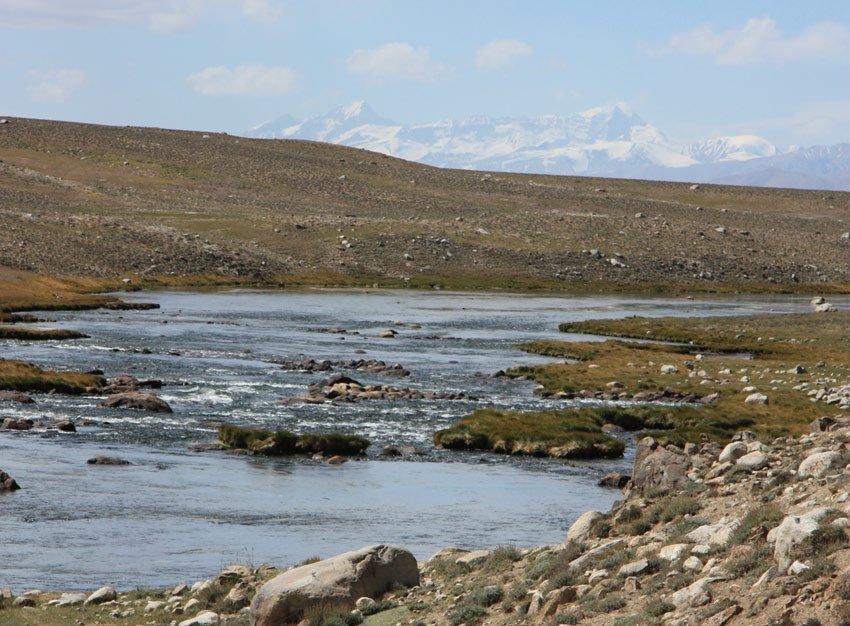Amu Darya (formerly Oxus) River with the Pamir Range on the horizon
The new moon in early February marks the beginning of the Tibetan year of the Iron Tiger. In the Nyingma tradition of Vajrayana Buddhism, one day each month is marked to celebrate the life and teachings of Guru Padmasambhava, the tantric master who came to Tibet in the 8th century and helped establish Buddhism in the Land of Snows. The tenth of each lunar month is designated a white day when practice and a ritual feast centers on a period in the life of this great teacher. Eight of these emanations are traditionally grouped together and often individually depicted as the main subject in thangkas. The other four, though not as well known, also derive from Guru Rinpoche's biography. The order in which these emanations appear throughout the year does not reflect a chronological unfolding of events in Padmasambhava's life but is presented as a way to contemplate the manner in which the extraordinary energy of transcendent awakening is expressed amidst the conventions of human society. A text composed by His Holiness Dudjom Rinpoche states,
The First Month: On the Tenth Day of the month of the Hare, having renounced His kingdom, He practices austerities, yoga, and liberation in the great cremation ground of Sitavana, "the cool forest." At the time of gathering all the Matrikas and Dakinis under His power, He became known as Guru Santaraksita, "the Guru who is the guardian of peace."So the first form indicated in the sequence is not a birth story but instead focuses on the immediacy of the young prince dropping out of courtly life, walking away from the power and pleasures of the kingdom and taking up residence in a cremation ground. Demonstrating a fierce determination to abandon all worldly ambitions marks this course of action, liberating energy and attention to initiate the yogic process of purification culminating in ego-death and full awakening to ground awareness
On the outer level, the appellation 'Santarakshita' echoes the name of Padma's enlightened cohort, the abbot of Nalanda and their work together with King Trisong Deutsen introducing Vajrayana Buddhism to Tibet. The name Santarakshita is Sanskrit and may be translated as 'peace-protector'. On the inner level, this reflects an intensity of resolve to break through the social and psycho-emotional confines of worldly involvement where there is no peace or lasting contentment and to re-orient and transform body and mind in the light of dharma. According to the Padma bKa'i thang, "Now the Prince who was the best of men thought: "By assuming the throne, I will not ensure the good of human beings; they will fall in great numbers into the abyss of perdition. I will find a means of renouncing the kingdom."
The exact location of Urgyen is still not precisely known. While some believe it to have been in the Swat Valley of Pakistan, I am of the opinion that it was more likely a small kingdom situated near the delta of the Oxus River, south of the Aral Sea. Having left the palace at Oddiyana, Padma hastens southeast,on a 'marvelous horse.' Following the Oxus upstream, he would ride for a few weeks before arriving in the town of Termiz in present day Uzbekistan. Here the trails leave the river valley and heads south, ascending into the mountains of Afghanistan. Passing through Kabul and the narrows of the Khyber pass, he crosses the Indus River and makes his way to the western end of the Ganges basin. Here, Padma dismounts and occupies a cavern where he attained "the perfect state" within seven days. Then, thinking of the work ahead, he continues east to the charnel ground known as Chilly Grove, a site not far from Bodhgaya where he will spend the next five years in the presence of a throng of devoted dakinis.
The emanation of Guru Sanataraksita indicates fearless renunciation, the determination to walk away from all pointless involvement and open oneself to the rawness of naked experience, to know mind directly, devoid of hope, fear and pretension. This is where the path begins. Dwelling in the cremation ground of Chilly Grove with his back leaning on the central stupa called Structure Which Give Happiness, Padma reveals his understanding regarding the true nature of self and world and brought the dakinis 'under his sway.' Upon his arrival here, the Orgyen Lingpa's text refers to him as Padma Gyalpo. Remaining here for five years as master of the dakinis, Dudjom Rinpoche identifies him with the emanation known as Guru Guardian of Peace.
Padma bKa'i Thang Canto 22
(Dharma, 1978)


No comments:
Post a Comment